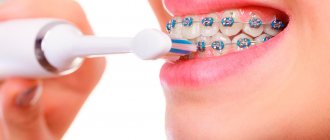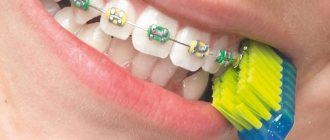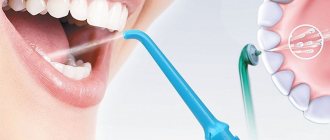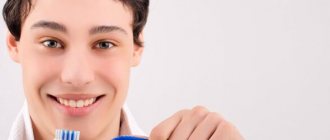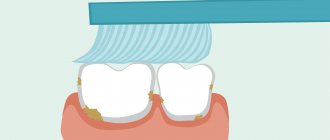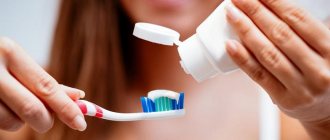03/13/2018 Editor
Mass production of electric toothbrushes began in the 60s of the last century. Modern devices are radically different from their predecessors, both in appearance and in the quality of cleaning tooth enamel. Despite the wide range of positive qualities and good reviews from dentists, not every person knows how to brush their teeth with an electric toothbrush. Let's look at this issue and learn about the main nuances of operating the device.
- 3.1 Precautions
Characteristics of electric brushes
Electric toothbrushes, first released in the 60s of the last century, are popular among dental care methods. Electric toothbrushes provide automatic vibration with a large number of movements per second, which a person is not able to repeat. Thanks to automatic movements, caring for teeth is easy and children also find it interesting.
Modern types of electric brushes differ favorably in many respects from their first analogues. The main characteristics of various models include:
- Soft pulsation of reciprocating movements;
- Several cleaning speeds, for example, lower for sensitive areas of gums and teeth;
- The great benefit of an electric toothbrush is its ergonomic shape, which makes cleaning easy for users of all ages;
- Partially reconfigurable for maneuverability and increased stability in the mouth;
- Provided change of nozzles;
- Reliable battery with charging indication.
Advantages of the device
Electric toothbrushes have many benefits:
- This device provides a whole range of possibilities for cleaning, massage and care of the oral cavity.
- Moving bristles and several operating modes facilitate and speed up the cleaning process, and also allow you to thoroughly clean interdental spaces and hard-to-reach places, such as “sevens” and “eights.”
- Electric brushes make it much easier to care for orthodontic braces.
- Electric brushes deal with stains from tea or coffee 21% better than a regular manual brush, and with gingivitis - about 11%.
- Using an electric brush prevents the possibility of injury to the gums or destruction of enamel. Provided proper operation and the correct choice of attachments, cleaning with this device is less traumatic.
- Children love brushing their teeth with a children's electric toothbrush. This makes the boring morning ritual interesting for them and they perform it with more enthusiasm.
Important! If you decide to purchase an electric toothbrush, then don’t skimp. Remember, a high-quality device cannot be cheap. The price of branded models starts from 7 thousand rubles. By choosing a cheaper device, you risk buying a fake, which can quickly break down, or, even worse, harm your health.
Benefits of electric toothbrushes
Dentists recommend the use of electric toothbrushes, since thanks to the active air-droplet flow, which is ensured by an increased rotation speed, the teeth of all patients, including children, can be gently cleaned, and dentures can be cleaned without damage. In addition, disabled people, as well as people who have problems with the motor system or do not have sufficient skills to use small objects, will solve the important task of maintaining oral hygiene with the help of an electric brush. As a result of the benefits of an electric toothbrush : fast and high-quality teeth cleaning.
Another advantage of a toothbrush: tooth enamel is not damaged at all . The technology of the reciprocating rotational cleaning mechanism allows you to clean the interdental space while simultaneously naturally whitening the tooth surface. Modern models are characterized by additional functions, including, for example, the ability to brush your front teeth for 30 seconds using any of the available modes. The installed timer will allow you to complete the procedure in full, which is not always possible when cleaning yourself.
One of the distinctive advantages of using an electric brush is also the prevention of gingivitis due to the vibration effect on the gums. With constant use, frequent bleeding of the gums is eliminated.
Ultrasonic electric toothbrushes not only effectively clean plaque, but also destroy tartar and deep deposits. In combination with the use of dental floss, this allows you to maintain the health and beauty of your teeth and oral cavity, and as a result, the procedure for professional oral hygiene becomes optional.
To briefly describe the benefits of an electric toothbrush , it consists of the following advantages:
- High-quality teeth cleaning;
- Removal of dental deposits and tartar removal;
- Convenient and safe cleaning in the presence of braces or dentures;
- Prevention of gingivitis;
- Strengthening gums and improving their blood circulation;
- Convenient calculation of cleaning time thanks to the timer;
- Saving your own money on professional oral hygiene;
Among the expensive models, there are specimens that have a useful ultraviolet lamp for disinfection. Enabling this function allows you to independently disinfect the oral cavity, which provides a high level of protection against infection and the development of caries.
Chewing teeth
Manipulations on the chewing organs are carried out as carefully as possible with special attention. They are at high risk of pulpitis and caries.
- The surface of the molars is cleaned from all sides.
- When brushing, lightly press the brush to treat the space between the teeth.
- For high-quality treatment of the interdental space, a special thread is used. Dentists recommend flossing daily. You need to tear off 50 centimeters of thread and wrap the ends around your fingers. Using your thumbs to pull the center section taut, gently move the floss between the molars. Near the gum tissue, you need to floss around the surface of the chewing organ.
- The lateral part of the molar is wiped with thread. This will remove any bacteria buildup.
It is better to start the hygiene procedure with floss, and then work with a brush. Devices with 2D technology (forward-reciprocating movements) and 3D technology (with the addition of pulsation) perfectly process molars, removing pathological plaque.
Harm from using electric toothbrushes
The danger with electric toothbrushes is that if used incorrectly, they can cause significant damage to your teeth.
The main negative aspect of using an electric brush is the thinning of tooth enamel, especially if a person has demineralization or fluorosis. In this case, it is better to choose a brush with softer bristles.
Due to the high speed of rotation of the bristles, an electric toothbrush can also cause harm in case of healing of any wounds in the oral cavity after surgery or dental intervention. In addition, it can complicate the situation with infectious periodontitis.
You should also change the head on your electric toothbrush at least once every 3-4 months, as a large number of germs and bacteria accumulate on it, and the bristles of the brush wear out, so cleaning will be less efficient.
Does everyone need an irrigator?
First of all, it is needed by those who find it difficult to floss: people with orthodontic structures such as braces and implants, those who have not had their wisdom teeth removed and the space between the teeth is too small to clean with dental floss, and people with disabilities. An irrigator will also come in handy if your gums are sensitive and dental floss causes them to bleed.
Some data say that floss cleans the interdental spaces better, others say that an irrigator does. So the choice between a thread and an irrigator is more a matter of convenience
. You can even use both: this is the most effective way to remove plaque between teeth.
Recommendations for caring for an electric toothbrush
An electric toothbrush has very soft and delicate bristles, which easily become dirty and therefore require careful care. To ensure that the brush is always absolutely clean, dentists recommend that after use, rinse it under a strong stream of hot water and then soap it. The soap can be washed off after a while or just before cleaning.
The brush must be dry before it is placed in a special case or glass. It is strictly prohibited to store a wet brush in a closed case to avoid the development and proliferation of bacteria and, consequently, the subsequent use of an electric toothbrush .
Some models provide for replacing the head with bristles, but in any case, if the question arises: how often should you change a toothbrush, doctors at our medical center strongly advise replacing the brush or bristles more than once within three months. In new models, the bristles are designed to last from 1 to 12 months, but this does not mean that replacement must be made after a year. Make sure to promptly follow this recommendation for reasons of benefit and hygiene, especially since some expensive models provide a wear indicator that will indicate the need for replacement.
How about cleaning your tongue? If yes, then with what?
Bacteria that cause tooth decay also multiply on the tongue. But there is no evidence that everyone needs to clean it. A study of 251 subjects found that brushing the tongue helps get rid of bad breath - halitosis.
. But there is no exact data on how often and for how long to clean your tongue, what technique to use.
Manufacturers offer special tongue scrapers
, which do not cause a gag reflex, and recommend brushing your tongue twice a day after brushing your teeth. You should start from the root of the tongue, where most bacteria accumulate. Using gentle pressure, you first need to move from the root of the tongue to its tip, and then treat the side surface, right and left.
The benefits and harms of electric toothbrushes: summary
After analyzing the advantages and disadvantages of using an electric toothbrush, we can conclude that the benefits of using an electric toothbrush are much greater than the harm and any negative consequences. Despite the high cost, the benefits of an electric toothbrush are obvious - better teeth cleaning, ease of use and prevention of oral diseases.
The number of electric toothbrushes is impressive in terms of shape, useful functions, various levels of performance and protection of tooth enamel. In this regard, before purchasing an electric toothbrush, do not be lazy to consult with experienced dentists to find the most appropriate model for a particular user.
Cleaning the outside of your teeth
A mandatory rule is the conditional division of the oral cavity into parts: upper (right and left) and lower (right and left). This is necessary to improve the quality of cleaning in order to treat all areas.
- The hygiene procedure can be started from any quarter. The time spent on this is up to 40 seconds. The surface of each unit is cleaned separately.
- The procedure needs to start from the outside, then move on to the inside. The movements should be sweeping, their direction should be up and down.
- First, the head is applied to the edge of the gums, then moved to the chewing plane of the unit. There is no need to keep the device in one area for a long time.
At the first stage of the hygiene procedure, the outside is always cleaned. It is more convenient to start with the upper jaw. Quality indicators will be enhanced by the smooth movement of the head from tooth to tooth with a delay of no more than 1-2 seconds. This is easy as the device is programmed with the correct rotation method.
Contraindications
Almost all contraindications to using an electric brush are relative or temporary. The use of the device should be discontinued in the following clinical situations :
- after surgery in the dentofacial area;
- stomatitis;
- tooth mobility grade 3;
- after oncological surgery;
- hypertrophic gingivitis.
Note! Only after eliminating such pathologies or abnormalities can you begin to use an electric device for brushing your teeth.
If you experience unpleasant sensations while using the brush, it is better to abandon them completely.
Is pressing required?
The cleaning process does not require special pressure, as this is harmful to the enamel. Even low power attachments operate at 4000 rpm. You just need to turn on the required mode: maximum or gentle cleaning.
Some modern models have sensors that control the pressure applied, as well as a timer that shows the time required to clean a segment of the dentition. Electronic “smart” devices are very convenient to use, but they are also expensive: the cost starts from 7-10 thousand rubles.
How to choose pasta?
It is best to use the toothpaste recommended by your doctor. People with healthy teeth can use universal hygienic toothpastes . They have an antiseptic effect, whiten and freshen breath.
For the purpose of prevention, sometimes it is necessary to switch to pastes to prevent caries and periodontal lesions . They contain fluorine and calcium compounds.
Important! You need to be as careful as possible with whitening pastes, since they contain chemical oxidizing agents or abrasive particles.
Such products are contraindicated for those who have increased enamel sensitivity.
Children are advised to use low fluoride toothpastes . In the period from 6 to 13 years, it is necessary to give preference to products with a minimal amount of abrasive substances and a high calcium content. Upon reaching 13 years of age, you can switch to adult pastes.

